
1
Item #1002 926 596
Model #7107-03
USE AND CARE GUIDE
VENTILATION FAN
Questions, problems, missing parts? Before returning to the store,
call Hampton Bay Customer Service
8 a.m. - 7 p.m., EST, Monday-Friday, 9 a.m. - 6 p.m., EST, Saturday
1-855-HD-HAMPTON
HAMPTONBAY.COM
THANK YOU
We appreciate the trust and confidence you have placed in Hampton Bay through the purchase of this ventilating bath fan. We strive to
continually create quality products designed to enhance your home. Visit us online to see our full line of products available for your home improvement needs.
Thank you for choosing Hampton Bay!

2
Table of Contents ........................................................... 2
Safety Information .......................................................... 2
Product Specications ................................................... 3
Typical Installation .......................................................... 3
Wiring Diagram ............................................................... 3
Quick connector instructions ...................................................3
Warranty .......................................................................... 4
5-YEAR LIMITED WARRANTY ...................................................4
What is Covered......................................................................4
Pre-installation................................................................ 4
Planning Installation ................................................................4
Tools Required ........................................................................4
Package Contents ...................................................................5
Installation - New Construction .................................... 6
Installation - Existing Construction .............................. 8
Care and Maintenance ................................................. 10
Troubleshooting ............................................................ 11
Table of Contents
Safety Information
Please read and understand this entire manual before attempting to assemble, operate or install the
product.
1. Always disconnect the power supply prior to servicing the fan, motor or junction box.
2. Follow all local building, safety and electrical codes as well as NEC (National Electrical Code) and OSHA (Occupational Safety and Health Act).
3. Electric Service supply must be 120 volts, 60 hertz.
4. This product must properly connect to the grounding conductor of the supply circuit.
5. Do not bend or kink the power wires.
6. Do not use this fan with any solid state control device, such as a remote control, dimmer switch, or certain timers. Mechanical timers are not
solid state devices.
7. Do not install in a ceiling with insulation greater than R40.
8. Duct work should be installed in a straight line with minimal bends.
9. Duct work size must be the same size as the discharge and should not be reduced. Reducing the duct size may increase fan noise.
WARNING: To reduce the risk of fire, electric shock, or injury to persons, observe the following:
10. Use this unit in the manner intended by the manufacturer. If you have any questions. Please call customer service.
11. Before servicing or cleaning unit, switch power off at service panel and lock the service disconnecting means to prevent power from being
switched on accidentally. When the service disconnecting means cannot be locked, securely fasten a prominent warning device, such as a tag,
to the service panel.
12. Installation work and electrical wiring must be done by a qualified person(s) in accordance with all applicable codes and standards, including
fire-rated construction.
13. Sufficient air is needed for proper combustion and exhausting of gases through the flue (chimney) of fuel burning equipment to prevent backdrafting.
Follow the heating equipment manufacturer’s guideline and safety standards such as those published by the National Fire Protection Association
(NFPA), and the American Society for Heating, Refrigeration and Air Conditioning Engineers (ASHRAE) and local code authorities.
14. When cutting or drilling into the wall or ceiling, do not damage electrical wiring and other hidden utilities.
15. Ducted fans must always be vented to the outdoors.
16. If this unit is to be installed over a tub or shower, it must be marked as appropriate for the application and be connected to a GFCI (Ground Fault
Circuit Interrupter) – protected branch circuit.
CAUTION: For general ventilating use only. Do not use to exhaust hazardous or explosive materials and vapors.
CAUTION: Not for use in cooking areas.
CAUTION: To reduce the risk of injury to persons, install the fan at least 7 feet (2.1m) above the floor.

3
HAMPTONBAY.COM
Please contact 1-855-HD-HAMPTON for further assistance.
Product Specication
Typical Installation
Wiring Diagram
SPECIFICATIONS SPECIFICATIONS
Airflow: 110 CFM Power consumption: 33W
120 V, 60 Hz Weight: 14.5 lbs.
Duct diameter: 4 in.
Ceiling Opening Dimension Requirements: 10-13/16 in. (L) x 10-1/2 in.
(W) x 8-1/2 in. (H)
Sound output: 1.0 Sones
The ducting from this fan to the outside of the
building has a strong effect on the air flow, noise and
energy use of the fan. Use the shortest, straightest
duct routing possible for best performance, and
avoid installing the fan with smaller ducts than
recommended. Insulation around the ducts can
reduce energy loss and inhibit mold growth. Fans
installed with existing ducts may not achieve
their rated air flow.
OR
Roof cap (with
built-in damper)
Caulk
termination
to duct
Wall cap
(with
built-in
damper)
Properly insulate
around fan to
minimize building
heat loss and gain
Fan housing
Seal any gap around
fan housing
2-3 foot straight run
before elbow
duct helps alignment
and absorbs sound
Automatic terminal switch
Black wire
to 120V AC 60Hz
To switch
To neutral
To ground
Junction box
FAN HOUSING
White wire
Green wire
Motor
Capacitor for
long life of
motor
WARNING: Wiring must comply with all applicable electrical
codes. Turn OFF power before removing or installing connectors
WARNING: COPPER TO COPPER ONLY. Do not use Aluminum wire.
CAUTION: Accessory part (quick connector) should meet
• Strip wires 3/8 in. - 1/2 in.
• Grip the wire firmly and push
the stripped end of the wire into
the open port of the connector.
Use only one conductor per port.
• Verify the stripped end of the
wires is fully inserted to the
back of the connector.
Quick
connect
House
wires
Product
wires
NOTE: Important wire information. Maximum temperature rating 105˚C
(221˚F). 600 volts maximum for building wire and 1000 volts maximum
for building wire and 1000 volts maximum in signs and lighting fixtures.
The acceptable wire range includes: Solid: 12-18 AWG.

4
5-YEAR LIMITED WARRANTY
WHAT IS COVERED
If this product fails due to a defect in materials or workmanship at any time during the first FIVE years of ownership, the manufacturer will replace it free
of charge, postage-paid at their option. This warranty does not cover products that have been abused, altered, damaged, misused, cut or worn. This
warranty does not cover use in commercial applications. Use only manufacturer-supplied genuine warranty repair replacement parts to repair this fan. Use of
non-genuine repair parts will void your warranty. The manufacturer DISCLAIMS all other implied or express warranties including all warranties of merchant-
ability and/or fitness for a particular purpose. As some states do not allow exclusions or limitations on an implied warranty, the above exclusions and
limitations may not apply. This warranty gives you specific legal rights, and you may have other rights that vary from state to state.
This warranty is limited to the replacement of defective parts only. Labor charges and/or damage incurred during installation, repair, replacement as well
as incidental and consequential damages connected with the above are excluded. Any damage to this product as a result of neglect, misuse, accident,
improper installation or use other than the purpose SHALL VOID THIS WARRANTY. Shipping costs for return product as part of a claim on the warranty
must be paid for by the customer.
Contact the Customer Service Team at 1-855-HD-HAMPTON or visit www.HAMPTONBAY.com.
Warranty
Pre-installation
PLANNING INSTALLATION
Before beginning assembly of the product, make sure all parts are present. Compare parts with the package contents list and hardware contents. If
any part is missing or damaged, do not attempt to assemble the product.
WARNING: Turn off electricity at breaker box before beginning
installation.
Carefully remove the unit from the carton.
Check area above installation location to be sure that wiring can run to the planned location and that duct work can be run and the area is sufficient
for proper ventilation.
Inspect duct work and wiring before proceeding with installation.
Before installation, provide inspection and future maintenance access at a location that will not interfere with installation work.
You may need the help of a second person to install this fan; one person on the attic side and one on the room side.
NOTE: Installation may vary depending on how the previous bath fan
was installed. Supplies necessary for the installation of your bath fan are
not all included. However, most are available at your local home
improvement or hardware store.
TOOLS REQUIRED (not included)
Claw
hammer
Drill
bits
Flathead
screwdriver
Duct
tape
Phillips head
screwdriver
Utility
knife
Electric
drill

5
HAMPTONBAY.COM
Please contact 1-855-HD-HAMPTON for further assistance.
Pre-installation (continued)
PACKAGE CONTENTS
A
B
F
G
H
C
D
E
Part Description Quantity
A Fan housing 1
B Grille 1
C Long wood screws (M4x30mm) 8
D Machine screw (M4x12mm) 2
E Short machine screw (M4x10mm) 1
F Suspension bracket I 1
G Suspension bracket II 1
H Suspension bracket III 1

6
Installation - New Construction
CAUTION: Make sure power is switched o at service
panel before starting installation.
NOTE: Ceiling mount only.
1
Attaching fan housing to the ceiling joist
A
C
0.24"
CAUTION: Allow for the thickness of ceiling board used
in your application. Do not ush mount to joist. Flange
should be ush with the bottom of the ceiling board.
If spacing between joists is 12 in. apart, use 4 long wood
screws (C) to attach the fan housing (A) directly to the joists
from the bottom through the ceiling board.
2
Attach fan housing to the ceiling joist
using suspension brackets
If spacing between joists is 16 in. - 24 in., insert suspension
bracket I (F) into the bracket cover on the duct connector side
of the fan housing (A). Then, attach suspension bracket II (G)
and suspension bracket III (H) to the back of the fan housing
(A).
3
Securing fan housing to ceiling joist
Secure the fan housing (A) to the joist with suspension brackets
(G, H) using long wood screws (C).
A
F
G
A
C
G, H
H

7
HAMPTONBAY.COM
Please contact 1-855-HD-HAMPTON for further assistance.
Installation - New Construction (continued)
4
Securing suspensions brackets onto fan
housing
Secure suspension brackets (G, H) to the fan housing (A)
using the two machine screws (D) and secure suspension
bracket (F) to the other side of housing using the short
machine screw (E).
5
Removing wiring cover on the fan housing
Quick
Connector
Product
Wires
House
Wires
5.1
Remove the wiring cover. Pull the house wires through the
wire box cover hole (5.1). Using the quick connector, secure
120 V AC house wiring from the wall switch to the fan as
shown in the wiring diagram on page 3. 14 AWG is the small-
est conductor that should be used for branch circuit wiring.
Carefully push the connected wires back into the wiring box
housing. Reattach the wiring box cover (5.1).
CAUTION: If the electrical wires do not match the colors
listed, you must determine what each house wire represents
before connecting. You may need to consult an electrical
contractor to determine safely.
6
Connecting the duct
Connect a 4 in. circular duct (not supplied) and vent to the
outside. Secure it with duct tape (not supplied) or a clamp (not
supplied) to make the connection secure and air tight.
Turn on the power source. Check the fan for any abnormal
sound or vibration.
7
Installing the grille
B
A
Attach the grille (B) by pinching the mounting springs and
inserting into the narrow rectangular slots in the fan housing (A).
A
E
F
G, H
D

8
Installation - Existing Construction
1
Remove the existing fan
Remove the old fan from the ceiling.
2
Measure the ceiling opening
1
1
1
1
0
9
8
7
6
5
4
Measure the opening to ensure it is large enough to
accommodate the new fan body (A) (10.8 in. x 10.5 in.).
3
Enlarge the opening (optional)
10.8"
10.5"
If this fan is not replacing an old fan, be sure to cut a
10.8 in. x 10.5 in. opening for the fan body (A).
MAKE SURE ONE EDGE OF THE OPENING IS FLUSH
WITH THE JOIST FOR INSTALLATION FROM BELOW.
INSTALLATION FROM ABOVE WITH SUSPENSION BRACKETS (ATTIC ACCESSIBLE) ONLY IF UNABLE TO ATTACH DIRECTLY TO JOIST
1
Removing duct connector
Remove the duct connector from the fan housing.
Insert the fan housing into the opening cut in the drywall.

9
HAMPTONBAY.COM
Please contact 1-855-HD-HAMPTON for further assistance.
Installation - Existing Construction (continued)
2
Attaching fan housing to the ceiling joist
A
C
0.24"
CAUTION: Allow for the thickness of ceiling board used
in your application. Do not ush mount to the joist.
Flange should be ush with the bottom of the ceiling
board.
If spacing between joists is 12 in. apart, use 4 long wood
screws (C) to attach the fan housing (A) directly to the joists
from the bottom through the ceiling board.
3
Attaching fan housing to the ceiling joist
using suspension brackets
If spacing between joists is 16 in. - 24 in., and you have attic
access above, insert suspension bracket I (F) into the bracket
cover on the duct connector side of the fan housing (A). Then,
attach suspension bracket II (G) and suspension bracket III
(H) to the back of the fan housing (A).
4
Securing fan housing to ceiling joist
Secure the fan housing (A) to the joist with suspension brackets
(G, H) using long wood screws (C).
5
Securing suspensions brackets onto fan
housing
Secure suspension brackets (G, H) to the fan housing (A)
using the two machine screws (D) and secure suspension
bracket (F) to the other side of housing using the short
machine screw (E).
6
Reconnecting duct connector
Attach the duct connector to the fan housing (A).
A
F
G
H
C
G, H
A
A
A
D
G, H
E
F

10
7
Connecting the duct
Connect a 4 in. circular duct (not supplied) and vent to the outside.
Secure it with duct tape (not supplied) or clamp (not supplied) to
make the connection secure and air tight.
8
Removing wiring cover on the fan housing
Quick
Connector
Product
Wires
House
Wires
8.1
Remove the wiring cover. Pull the house wires through the
wire box cover hole (8.1). Using the quick connector, secure
120 V AC house wiring from the wall switch to the fan as
shown in the wiring diagram on page 3. 14 AWG is the smallest
conductor that should be used for branch circuit wiring.
Carefully push the connected wires back into the wiring box
housing. Reattach the wiring box cover (8.1).
CAUTION: If the electrical wires do not match the colors
listed, you must determine what each house wire represents
before connecting. You may need to consult an electrical
contractor to determine safely.
9
Installing the grille
B
A
Attach the grille (B) by pinching the mounting springs and
inserting into the narrow rectangular slots in the fan housing
(A).
Installation - Existing Construction (continued)
WARNING: Disconnect power supply before servicing.
See SAFETY INFORMATION before proceeding. Routine maintenance should be done at least once a year.
Never use solvents, thinner or harsh chemicals for cleaning the fan.
Do not allow water to enter the motor.
Do not immerse metal parts in water.
Care and Maintenance

11
HAMPTONBAY.COM
Please contact 1-855-HD-HAMPTON for further assistance.
Troubleshooting
Problem Possible Cause
Solution
The fan seems louder than
it should.
The CFM is too great.
Be sure the CFM rating on the fan matches the square
footage of your room.
The damper is damaged or not working properly.
Check the damper to ensure it is opening and closing
properly. If the damper has become damaged, please call
Customer Service.
The bend in the duct is too close to the fan discharge.
Be sure you do not have any sharp bends in the duct closer
than 18 in. to the fan discharge.
The fan discharge is reduced to fit a smaller duct. Use the recommended size ducting to reduce fan noise.
The fan body is not attached securely. Be sure the fan is securely attached to the ceiling joists.
The fan is not clearing the
room.
There is insufficient airflow intake in the room.
Be sure a door or window is slightly ajar or opened to allow
airflow. The fan is not able to draw air out of the room without
enough airflow to draw from.
There is insufficient CFM. Be sure the CFM rating on the fan matches the requirements
for your room size.
NOTE: Using a tissue is not the correct method for
determining if the fan is operating properly. If the fan
clears steam from the room within approximately 15
minutes of completeing your shower, then the fan is
operating properly.

Questions, problems, missing parts? Before returning to the store,
call Hampton Bay Customer Service
8 a.m. - 7 p.m., EST, Monday-Friday,
9 a.m. - 6 p.m., EST, Saturday
1-855-HD-HAMPTON
HAMPTONBAY.COM
Retain this manual for future use.

1
Item #1002 926 596
Modelo #7107-03
GUÍA DE USO Y CUIDAD
VENTILADOR
Preguntas, problemas, partes faltantes? Antes de regresar a la tienda,
llamar al servicio de atención al cliente de Hampton Bay
8 a.m. - 7 p.m., EST, lunes a viernes, 9 a.m. - 6 p.m., EST, sábado
1-855-HD-HAMPTON
HAMPTONBAY.COM
GRACIAS
Agradecemos la confianza que depositó en Hampton Bay con la compra de este ventilador de baño de ventilación. Nos esforzamos por
crea continuamente productos de calidad diseñados para mejorar tu hogar. Visítenos en línea para ver nuestra línea completa de productos disponibles
para sus necesidades de mejoras del hogar. ¡Gracias por elegir Hampton Bay!

2
Tabla de Contenido ........................................................ 2
Información de seguridad.............................................. 2
Especicaciones del producto ...................................... 3
Instalación típic .............................................................. 3
Diagrama de cableado ................................................... 3
Instrucciones de conector rápido ............................................3
Garantía ........................................................................... 4
GARANTÍA LIMITADA DE 5 AÑOS .............................................4
Qué está cubierto ...................................................................4
Preinstalación ................................................................. 4
Instalación de planificación .....................................................4
Herramientas necesarias ........................................................4
Contenidos del Paquete ..........................................................5
Instalación - Nueva Construcción ................................ 6
Instalación - Construcción Existente ........................... 8
Cuidado y mantenimiento ............................................ 10
Solución de problemas ................................................ 11
Tabla de Contenido
Información de seguridad
Lea y comprenda todo este manual antes de intentar ensamblar, operar o instalar el producto.
1. Desconecte siempre la fuente de alimentación antes de reparar el ventilador, el motor o la caja de conexiones.
2. Siga todos los códigos locales de construcción, seguridad y electricidad, así como NEC (Código Eléctrico Nacional) y OSHA (Ley de Seguridad y
Salud Ocupacional).
3. El suministro del servicio eléctrico debe ser de 120 voltios, 60 hertzios.
4. Este producto debe conectarse correctamente al conductor de tierra del circuito de suministro.
5. No doble ni doble los cables de alimentación.
6. No use este ventilador con ningún dispositivo de control de estado sólido, como un control remoto, un atenuador de luz o ciertos temporizadores.
Los temporizadores mecánicos no son dispositivos de estado sólido.
7. No instale en un techo con un aislamiento superior a R40.
8. Los conductos deben instalarse en línea recta con curvas mínimas.
9. El tamaño del trabajo del conducto debe ser del mismo tamaño que la descarga y no debe reducirse. Reducir el tamaño del conducto puede
aumentar el ruido del ventilador.
ADVERTENCIA: Para reducir el riesgo de incendio, descarga eléctrica o lesiones personales, ob-
serve lo siguiente:
10. Use esta unidad de la manera prevista por el fabricante. Si tienes alguna pregunta. Por favor llame a servicio al cliente.
11. Antes de reparar o limpiar la unidad, apague la energía en el panel de servicio y bloquee los medios de desconexión del servicio para evitar que
la energía se encienda accidentalmente. Cuando los medios de desconexión del servicio no se puedan bloquear, asegure de forma segura un
dispositivo de advertencia prominente, como una etiqueta, al panel de servicio.
12. El trabajo de instalación y el cableado eléctrico debe realizarlo una persona calificada de acuerdo con todos los códigos y normas aplicables,
incluida la construcción con clasificación de resistencia al fuego.
13. Se necesita suficiente aire para la combustión adecuada y el escape de los gases a través de la chimenea (chimenea) del equipo que quema
combustible para evitar la retrogresión. Siga las pautas del fabricante de equipos de calefacción y las normas de seguridad como las publicadas
por la Asociación Nacional de Protección contra Incendios (NFPA) y la Sociedad Americana de Ingenieros de Calefacción, Refrigeración y Aire
Acondicionado (ASHRAE) y las autoridades locales de códigos.
14. Al cortar o taladrar en la pared o el techo, no dañe el cableado eléctrico y otros servicios ocultos.
15. Los ventiladores con conductos siempre deben ventilarse al aire libre.
16. Si esta unidad debe instalarse sobre una bañera o ducha, debe marcarse como aprpia da para la aplicación y conectarse a un circuito derivado
protegido por GFCI (Interruptor de circuito a tierra).
PRECAUCIÓN: Para uso general de ventilación solamente. No lo use para expulsar materiales y vapores
peligrosos o explosivos.
PRECAUCIÓN: No debe usarse en áreas de cocina.
PRECAUCIÓN: Para reducir el riesgo de lesiones a las personas, instale el ventilador al menos a 7 pies
(2,1 m) por encima del piso.

3
HAMPTONBAY.COM
Please contact 1-855-HD-HAMPTON for further assistance.
Especicaciones del producto
Instalación típica
Diagrama de cableado
PRESUPUESTO PRESUPUESTO
Flujo de aire: 110 CFM Consumo de energía: 33W
120 V, 60 Hz Peso: 14.5 lbs.
Diámetro del conducto: 4 in
Requisitos de la Dimensión de Apertura del Techo: 10-13 / 16 in. (L) x
10-1 / 2 in. (W) x 8-1 / 2 in. (H)
Salida de sonido: 1.0 Sones
La conducción desde este ventilador hacia el
exterior del edificio tiene un fuerte efecto en el flujo
de aire, el ruido y el uso de energía del ventilador.
Utilice el enrutamiento de conductos más corto y
recto posible para obtener el mejor rendimiento, y
evite instalar el ventilador con conductos más
pequeños que los recomendados. El aislamiento
alrededor de los conductos puede reducir la
pérdida de energía e inhibir el crecimiento de
moho. Los ventiladores instalados con conductos
existentes pueden no lograr su flujo de aire
nominal.
OR
Roof cap (with
built-in damper)
Caulk
termination
to duct
Wall cap
(with
built-in
damper)
Properly insulate
around fan to
minimize building
heat loss and gain
Fan housing
Seal any gap around
fan housing
2-3 foot straight run
before elbow
duct helps alignment
and absorbs sound
Automatic terminal switch
Black wire
to 120V AC 60Hz
To switch
To neutral
To ground
Junction box
FAN HOUSING
White wire
Green wire
Motor
Capacitor for
long life of
motor
ADVERTENCIA: El cableado debe cumplir con todos los req-
uisitos eléctricos aplicables códigos. Desconecte la corriente
antes de quitar o instalar los conectores
ADVERTENCIA: COBRE A COBRE SOLAMENTE. No use hilo de
aluminio
PRECAUCIÓN: la pieza accesoria (conector rápido) debe cumplir
• Pele los alambres 3/8 in. - 1/2 in.
• Agarre el cable con rmeza y empuje
el extremo pelado del cable en
el puerto abierto del conector.
Use solo un conductor por puerto.
• Vericar el extremo despojado del
cables está completamente insertado en
el parte posterior del conector.
Quick
connect
House
wires
Product
wires
NOTA: información importante sobre el cable. Temperatura máxima de 105 ° C (221 ° F). 600
voltios como máximo para cables de construcción y 1000 voltios como máximo para cables
de construcción y 1000 voltios como máximo en rótulos e iluminación. El rango aceptable de
cables incluye: Sólido: 12-18 AWG.

4
GARANTÍA LIMITADA DE 5 AÑOS
LO QUE ESTÁ CUBIERTO
Si este producto falla debido a un defecto en los materiales o mano de obra en cualquier momento durante los primeros CINCO años de propiedad, el fabri-
cante lo reemplazará de forma gratuita, con franqueo pagado a su opción. Esta garantía no cubre productos que han sido maltratados, alterados, dañados,
mal utilizados, cortados o desgastados. Esta garantía no cubre el uso en aplicaciones comerciales. Utilice únicamente repuestos originales de reparación
de garantía provistos por el fabricante para reparar este ventilador. El uso de piezas de repuesto no originales anulará la garantía. El fabricante RENUNCIA
a todas las demás garantías implícitas o expresas, incluidas todas las garantías de comerciabilidad y / o idoneidad para un fin determinado. Como algunos
estados no permiten exclusiones o limitaciones en una garantía implícita, es posible que las exclusiones y limitaciones anteriores no se apliquen. Esta
garantía le otorga derechos legales específicos, y usted puede tener otros derechos que varían de estado a estado.
Esta garantía está limitada a la sustitución de piezas defectuosas solamente. Se excluyen los costos de mano de obra y / o daños incurridos durante la
instalación, reparación, reemplazo así como los daños incidentales y consecuentes relacionados con lo anterior. Cualquier daño a este producto como
resultado de negligencia, uso indebido, accidente, instalación incorrecta o uso que no sea el propósito DEBERÁ ANULAR ESTA GARANTÍA. Gastos de envío
para devolución de producto como parte de un reclamo sobre la garantía
Garantía
Preinstalación
INSTALACIÓN DE PLANIFICACIÓN
Antes de comenzar el ensamblaje del producto, asegúrese de que todas las piezas estén presentes. Compare las partes con la lista de contenido del
paquete y el contenido del hardware. Si alguna parte falta o está dañada, no intente ensamblar el producto.
ADVERTENCIA: apague la electricidad en la caja del
interruptor antes de comenzar la instalación.
Retire con cuidado la unidad de la caja de cartón.
Verifique el área por encima de la ubicación de instalación para asegurarse de que el cableado pueda llegar a la ubicación planificada y de que se
pueda hacer funcionar el conducto y que el área sea suficiente para una ventilación adecuada.
Inspeccione el trabajo del conducto y el cableado antes de continuar con la instalación.
Antes de la instalación, proporcione inspección y acceso de mantenimiento futuro en una ubicación que no interfiera con el trabajo de instalación.
Es posible que necesite la ayuda de una segunda persona para instalar este ventilador; una persona en el lado del ático y otra en el lado de la
habitación.
NOTA: La instalación puede variar dependiendo de cómo se instaló el ventilador
de baño anterior. Los suministros necesarios para la instalación de su ventilador
de baño no están incluidos. Sin embargo, la mayoría están disponibles en su
tienda local de mejoras para el hogar o ferretería.
HERRAMIENTAS REQUERIDAS (no incluidas)
Garra
martill
Perforar
bits
Flathead
destornillador
Conducto
cinta
Destornilla-
dor Phillips
Utilidad
cuchillo
Eléctrico
perforar

5
HAMPTONBAY.COM
Please contact 1-855-HD-HAMPTON for further assistance.
Preinstalación (continuación)
CONTENIDOS DEL
A
B
F
G
H
C
D
E
Parte Descripción Cantidad
A Alojamiento del ventilador 1
B Reja 1
C
Tornillos de madera largos (M4x-
30mm)
8
D Tornillo de la máquina (M4x12mm) 2
E
Tornillo de máquina corto (M4x-
10mm)
1
F Soporte de suspensión I 1
G Soporte de suspensión II 1
H Soporte de suspensión III 1

6
Instalación - Nueva Construcción
PRECAUCIÓN: asegúrese de que la energía esté de-
sconectada en el panel de servicio antes de comenzar
la instalación.
NOTA: solo montaje en techo.
1
Colocación de la carcasa del ventilador
en la viga del techo
A
C
0.24"
PRECAUCIÓN: permita el espesor del panel de techo utilizado
en su aplicación. No instale el soporte al ras en la vigueta. El
reborde debe estar alineado con la parte inferior del tablero del
techo.
Si el espacio entre las viguetas es de 12 pulgadas de sep-
aración, use 4 tornillos de madera largos (C) para unir la
carcasa del ventilador (A) directamente a las viguetas desde
la parte inferior a través de la placa del techo..
2
Fije la carcasa del ventilador a la vigueta
del techo usando soportes de suspensión
Si el espacio entre las vigas es de 16 in. - 24 in., Inserte el
soporte de suspensión I (F) en la cubierta del soporte en el
lado del conector del conducto de la carcasa del ventilador
(A). Luego, je el soporte de suspensión II (G) y el soporte
de suspensión III (H) a la parte posterior de la carcasa del
ventilador (A).
3
Fijación de la carcasa del ventilador a la viga
del techo
Asegure la carcasa del ventilador (A) a la vigueta con los
soportes de suspensión (G, H) utilizando tornillos largos para
madera (C).
A
F
G
A
C
G, H
H

7
HAMPTONBAY.COM
Por favor, póngase en contacto con 1-855-HD-HAMPTON para obtener más ayuda.
Instalación - Construcción Nueva (continuación)
4
Fijación de los soportes de las suspensiones en
la carcasa del ventilador
Fije los soportes de suspensión (G, H) a la carcasa del ventila-
dor (A) utilizando los dos tornillos para metales (D) y asegure
la ménsula de suspensión (F) al otro lado de la carcasa utili-
zando el soporte corto tornillo de máquina (E).
5
Extracción de la cubierta del cableado en
la carcasa del ventilador
Quick
Connector
Product
Wires
House
Wires
5.1
Retire la cubierta del cableado. Tire de los cables de la casa a través
del oricio de la tapa de la caja de cables (5.1). Usando el conector
rápido, asegure el cableado de la casa de 120 V CA desde el inter-
ruptor de pared al ventilador como se muestra en el diagrama de
cableado en la página 3. 14 AWG es el conductor más pequeño que
se debe usar para el cableado del circuito derivado.
Empuje con cuidado los cables conectados nuevamente dentro de
la carcasa de la caja de cableado. Vuelva a colocar la cubierta de la
caja de conexiones (5.1).
PRECAUCIÓN: Si los cables eléctricos no coinciden con los
colores indicados, debe determinar qué representa cada cable
de la casa antes de conectar. Es posible que deba consultar a
un contratista eléctrico para determinar con seguridad.
6
Conectando el conducto
Conecte un conducto circular de 4 in (no suministrado) y
ventile hacia el exterior. Asegúrelo con cinta adhesiva (no
incluida) o con una abrazadera (no incluida) para hacer la
conexión segura y hermética.
Encienda la fuente de poder. Verique el ventilador por cual-
quier sonido o vibración anormal..
A
E
F
G, H
D

8
Instalación - Construcción Existente
1
Eliminar el ventilador existente
Retire el viejo ventilador del techo.
2
Mida la abertura del techo
1
1
1
1
0
9
8
7
6
5
4
Measure the opening to ensure it is large enough to
accommodate the new fan body (A) (10.8 in. x 10.5 in.).
3
Enlarge the opening (optional)
10.8"
10.5"
Mida la abertura para asegurarse de que sea lo sucientemente
grande como para acomodar el nuevo cuerpo del ventilador (A)
(10.8 in. x 10.5 in.).
ASEGÚRESE DE QUE UN BORDE DE LA APERTURA ES FLUSH
CON LA VIGA PARA LA INSTALACIÓN DESDE ABAJO.
INSTALACIÓN DESDE ARRIBA CON LOS SOPORTES DE SUSPENSIÓN (ÁTICO ACCESIBLE) SOLAMENTE SI NO SE PUEDE UNIR DIRECTAMENTE A LA VIGA
1
Extracción del conector del conducto
Retire el conector del conducto de la carcasa del ventilador.
Inserte la carcasa del ventilador en el corte de apertura en el
panel de yeso

9
HAMPTONBAY.COM
Por favor, póngase en contacto con 1-855-HD-HAMPTON para obtener más ayuda.
Instalación - Construcción existente (continuación)
2
Colocación de la carcasa del ventilador
en la viga del techo
A
C
0.24"
PRECAUCIÓN: permita el espesor del panel de techo utilizado
en su aplicación. No instale el montaje al ras de la vigueta. El
reborde debe estar alineado con la parte inferior del tablero del
techo.
Si el espacio entre las viguetas es de 12 pulgadas de separación, use
4 tornillos de madera largos (C) para unir la carcasa del ventilador (A)
directamente a las viguetas desde la parte inferior a través de la placa
del techo.
3
Fijación de la carcasa del ventilador a la
vigueta del techo utilizando soportes de
suspensión
Si el espacio entre viguetas es de 16 in. - 24 in., Y tiene acce-
so al ático arriba, inserte el soporte de suspensión I (F) en la
cubierta del soporte en el lado del conector del conducto de
la carcasa del ventilador (A). Luego, je el soporte de suspen-
sión II (G) y el soporte de suspensión III (H) a la parte posteri-
or de la carcasa del ventilador (A).
4
Fijación de la carcasa del ventilador a la
viga del techo
Asegure la carcasa del ventilador (A) a la vigueta con los
soportes de suspensión (G, H) utilizando tornillos largos para
madera (C).
5
Fijación de los soportes de las suspen-
siones en la carcasa del ventilador
Fije los soportes de suspensión (G, H) a la carcasa del ventila-
dor (A) utilizando los dos tornillos para metales (D) y asegure
la ménsula de suspensión (F) al otro lado de la carcasa utili-
zando el soporte corto tornillo de máquina (E).
A
F
G
H
C
G, H
A
A
A
D
G, H
E
F

10
7
Conectando el conducto
Conecte un conducto circular de 4 in (no suministrado) y ventile
hacia el exterior. Asegúrelo con cinta adhesiva (no suministra-
da) o abrazadera (no incluida) para hacer la conexión segura y
hermética.
8
Extracción de la cubierta del cableado en
la carcasa del ventilador
Quick
Connector
Product
Wires
House
Wires
8.1
Retire la cubierta del cableado. Tire de los cables de la casa a
través del oricio de la tapa de la caja de cables (8.1). Usando
el conector rápido, asegure el cableado de la casa de 120 V CA
desde el interruptor de pared al ventilador como se muestra
en el diagrama de cableado en la página 3. 14 AWG es el
conductor más pequeño que se debe usar para el cableado
del circuito derivado.
Empuje con cuidado los cables conectados nuevamente
dentro de la carcasa de la caja de cableado. Vuelva a colocar
la cubierta de la caja de conexiones (8.1).
PRECAUCIÓN: Si los cables eléctricos no coinciden con
los colores indicados, debe determinar qué representa
cada cable de la casa antes de conectar. Es posible que
deba consultar a un contratista eléctrico para determi-
nar con seguridad.
Instalación - Construcción existente (continuación)
ADVERTENCIA: Desconecte la fuente de alimentación
antes de realizar el mantenimiento.
Ver INFORMACIÓN DE SEGURIDAD antes de continuar. El mantenimiento de rutina debe hacerse al menos una vez al año.
Nunca use disolventes, diluyentes o productos químicos fuertes para limpiar el ventilador.
No permita que entre agua en el motor.
No sumerja las partes metálicas en agua.
Cuidado y Mantenimiento

11
HAMPTONBAY.COM
Por favor, póngase en contacto con 1-855-HD-HAMPTON para obtener más ayuda.
Solución de problemas
Problema Causa posible
Solución
El ventilador parece más
fuerte de lo que debería.
El CFM es demasiado grande.
Asegúrese de que la calificación de CFM en el ventilador coin-
cida con la cantidad de pies cuadrados de su habitación.
El amortiguador está dañado o no funciona correcta-
mente.
Compruebe el amortiguador para asegurarse de que se
abre y se cierra correctamente. Si el amortiguador se ha
dañado, llame a Servicio al Cliente.
La curva en el conducto está demasiado cerca de la
descarga del ventilador.
Asegúrese de que no haya curvas cerradas en el conducto a
menos de 18 pulgadas de la descarga del ventilador.
La descarga del ventilador se reduce para adaptarse a
un conducto más pequeño.
Use los conductos de tamaño recomendado para reducir el
ruido del ventilador.
El cuerpo del ventilador no está conectado de forma
segura.
Asegúrese de que el ventilador esté bien sujeto a las vigas del
techo.
El ventilador no está limpi-
ando la habitación.
No hay suficiente entrada de flujo de aire en la
habitación.
Asegúrese de que una puerta o ventana esté ligeramente
entreabierta o abierta para permitir el flujo de aire. El ventilador
no puede extraer aire de la habitación sin suficiente flujo de
aire para extraerlo.
No hay suficiente CFM. Asegúrese de que la calificación de CFM en el ventilador coin-
cida con los requisitos para el tamaño de su habitación.
NOTA: Usar un pañuelo de papel no es el método
correcto para determinar si el ventilador funciona
correctamente. Si el ventilador despeja el vapor
de la habitación dentro de aproximadamente 15
minutos después de completar la ducha, entonces
el ventilador funciona correctamente.

Preguntas, problemas, partes faltantes? Antes de regresar a la tienda,
llamar al servicio de atención al cliente de Hampton Bay
8 a.m. - 7 p.m., EST, de lunes a viernes,
9 a.m. - 6 p.m., EST, sábado
1-855-HD-HAMPTON
HAMPTONBAY.COM
Guarde este manual para uso futuro.
-
 1
1
-
 2
2
-
 3
3
-
 4
4
-
 5
5
-
 6
6
-
 7
7
-
 8
8
-
 9
9
-
 10
10
-
 11
11
-
 12
12
-
 13
13
-
 14
14
-
 15
15
-
 16
16
-
 17
17
-
 18
18
-
 19
19
-
 20
20
-
 21
21
-
 22
22
-
 23
23
-
 24
24
En otros idiomas
Documentos relacionados
-
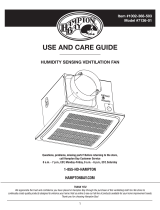 Hampton Bay 7136-01 Guía de instalación
Hampton Bay 7136-01 Guía de instalación
-
Hampton Bay BPT18-34A-2 Guía de instalación
-
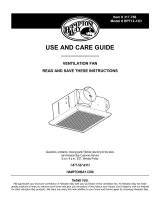 Hampton Bay BPT12-13D Manual de usuario
Hampton Bay BPT12-13D Manual de usuario
-
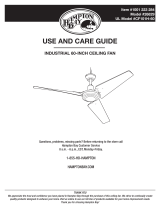 Hampton Bay 52869 Guía de instalación
Hampton Bay 52869 Guía de instalación
-
Hampton Bay 46008 Guía de instalación
-
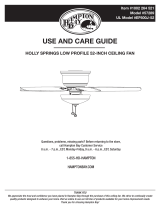 Hampton Bay 57289 Instrucciones de operación
Hampton Bay 57289 Instrucciones de operación
-
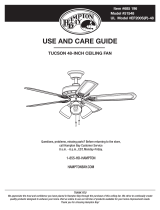 Hampton Bay 51548 Guía de instalación
Hampton Bay 51548 Guía de instalación
-
Unbranded 58020 Guía de instalación
-
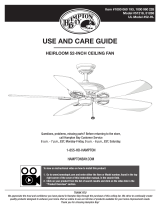 Hampton Bay 51218 Guía de instalación
Hampton Bay 51218 Guía de instalación
-
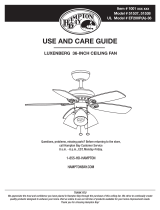 Hampton Bay 51538 Guía de instalación
Hampton Bay 51538 Guía de instalación

































